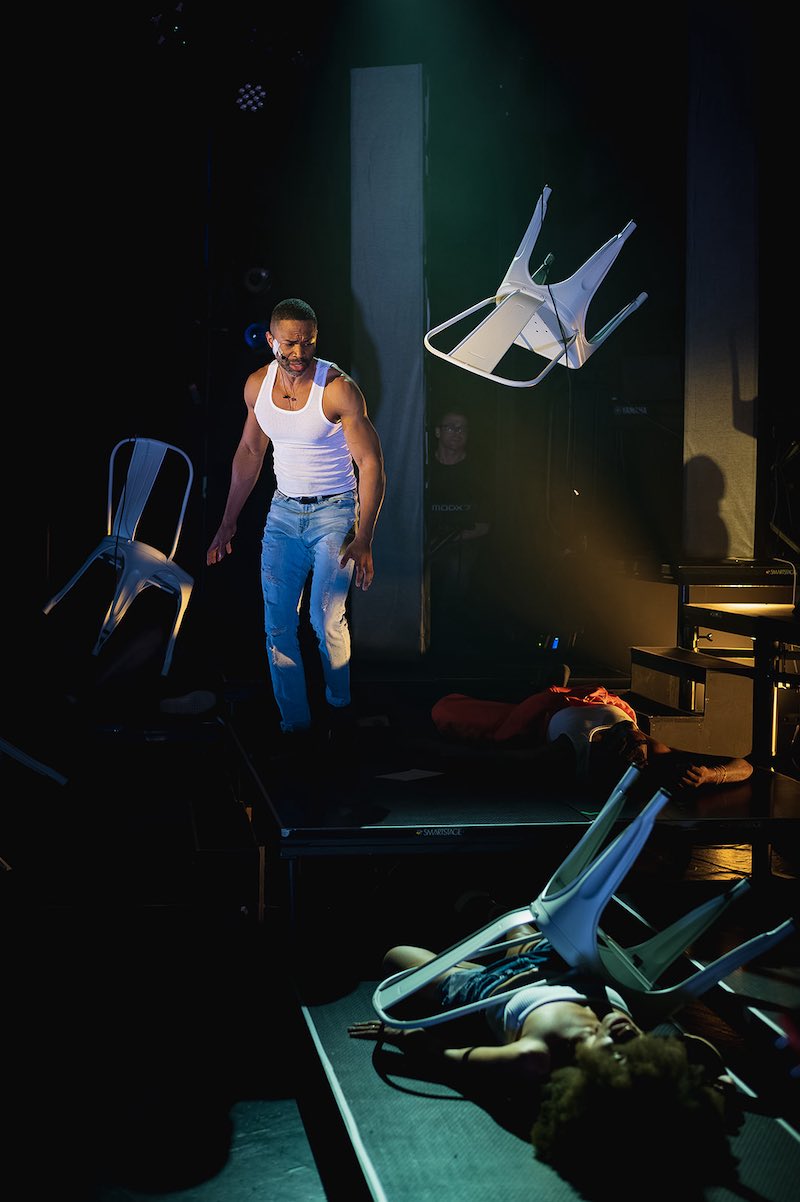In 1994 the Northridge earthquake occurred in Los Angeles, California. The John Adams/June Jordan work about this event (now playing for two more performances at the Atlas Performing Arts Center) begins with a chorus that hypnotically repeats the words in the title. It is as if we were overhearing a remembering, recital, and re-enactment of the event by some of its traumatized survivors:
I was looking at the ceiling.
I was looking at the ceiling.
I was looking at the ceiling.
And then I saw the sky.
The story follows seven survivors of that earthquake. We see the lives they had been leading prior to the earthquake and we see the shifts that take place in their lives as a result of the quake.

You may have noticed that lately there are a lot of “not-to-be-missed” theater events happening in Washington, DC. I would add I Was Looking at the Ceiling and Then I Saw the Sky to your list. There is not a boring moment in this show. Like much of what IN Series produces, this is an experience that is not soon to come again.
At the same time, I must point out that this show may not be for everyone. Isolation pervades the lives of these people onstage like the smoggy atmosphere of the Los Angeles they live in. While the lives of the characters affect and touch on each other, that interconnectedness is invisible to the characters themselves. This disconnected interconnectedness is not merely stated; it is also embodied in the way the work is constructed. What the audience is presented with is a series of disconnected vignettes, one after the other. The primary source of an almost subconsciously palpable connection is the variable repetition of the melodic lines that flow throughout the piece. You may find the frustration produced by this process to be so great that you are tempted to leave at the intermission. Please don’t. The earthquake that is the underlying catalyst and metaphor for this opera does not happen until the second act. And after that things proceed as though propelled by a rocket, finally leading to a reprise of that trauma-reenacting title song, which pulls together the diverse threads of this story in a way that is both glorious and gratifying.
The collection of characters whose lives we watch includes a womanizing urban African American preacher, David (played by DeMarcus Bolds). David is pursuing Leila, a nurse, (played by Shana Oshiro). Leila is treating and counseling Consuelo, a Salvadorean immigrant (played by Judy Yannini). Consuelo’s most recent child has been fathered by Dewain (played by Daniel J. Smith). Dewain is African American and a gang member trying to turn his life around. Dewain is defended by a lawyer, Rick (played by John Kun Park). Rick is the child of Vietnamese refugees. Rick finds himself being attracted to a white (and somewhat racially biased) news reporter, Tiffany (played by Louisa Waycott). Tiffany is attracted to the young white arresting police officer, Mike (played by Alan Naylor). Mike presents himself as “a man among men” in denial of the fact that he is gay. Over the course of the performance, we come to appreciate their resilience and nobility in the face of the particular form of class-and-race-based pressure that life in the USA imposes on its everyday citizens: pressure that this story suggests inevitably leads to eruptions like that represented by the earthquake in this story.

Louisa Waycott as Tiffany formidably embodies the frustration of a single white female trying to make a living and survive. Judy Yannini as Consuelo has a number of touching moments. The conclusion of her duet “One Last Look at the Angel in Your Eyes” with Daniel J. Smith (Dewain) drew sighs from the audience. Shana Oshiro’s delivery of “Leila’s Song” (“After all is said and done, I want to be somebody’s straight-up number 1”) was moving. Alan Naylor as Mike was vocally strong in a challenging portrayal of someone strategizing how to balance his contradictions in order to survive. DeMarcus Bolds as David projected the classic sexiness of a top-tier soul/gospel singer like Sam Cooke.
While it often seems that librettists don’t get no respect (what librettists’ names do you remember?), in this work the libretto and the music are equal partners. June Jordan’s words weave their own fugues in tandem with John Adams’ stream-of-consciousness melodies. Sometimes it’s like the words and the music are twinned yet independent Bach choirs that operate in a call-and-response counterpoint with each other as if they were part of some modern-day St. Matthew Passion.
In contrast to frustrations and isolation induced in the audience by the storyline, every harmonized a cappella sequence that we were presented with was delicious, comforting, and reassuring to hear. This reassurance was epitomized in “Song About the Bad Boys and the News” with its juxtaposition of Appalachian hymn eliding into an iconic urban girl group sass. John Adams’ vivid and vibrant music was almost a character itself. The conversation in the courtroom between the attorney Rick and the musical instruments impersonating the judge’s exasperated disgust and dismissal (“Your Honor, My Client He’s a Young Black Man”) is one effective example that, while it is not played for laughs, has its own ironic and bitter humor. (John Kun Park sang and performed this piece masterfully.) June Jordan’s libretto carries in it a faith in the humanity of people, in the face of conditions that don’t honor a people’s humanity.

A.J. Guban’s fog-and-shadow set is evocative and effective from beginning to the end, providing space for the musicians in its many nooks and crannies. At the beginning, the characters carry out their lives, walking through smog on multi-leveled platforms, in the midst of a city the architecture of which is comprised of Brutalist pillars that are reminiscent of New York’s Twin Towers. In the second act, after the earthquake, the actors hang, from the ceiling, those kind of cheap plastic chairs that we have all had occasion to use. The chairs dangle suspended at various angles evoking the dust and devastation wreaked by the earthquake.
Under the batons of Emily Balzer and David E. Chávez, the orchestral performances were alert, sharp, and brisk.
This John Adams/June Jordan collaboration is rarely produced. (This IN Series production is the first time the opera has been fully staged since its premiere.) Presenting Washington, DC, with unique theatrical experiences that you will not see anywhere else in the United States is the main reason that IN Series exists. Like much of the work IN Series mounts, I Was Looking at the Ceiling and Then I Saw the Sky reminds the audience of the possibilities of their humanity and connects the audience to its possibilities as citizens.
And at its conclusion, the performance received an enthusiastic, spontaneous, and well-deserved standing ovation.
Running Time: Two hours with an intermission.
I Was Looking at the Ceiling and Then I Saw the Sky plays next on April 29 (7:30 p.m.) and April 30 (3 p.m.), 2023, presented by IN Series performing at Atlas Performing Arts Center, Lang Theatre, 1333 H Street NE, Washington, DC. Tickets ($35–$55) are available online.
The program for I Was Looking at The Ceiling and Then I Saw the Sky is online here.
COVID Safety: Face masks are required at all times for all patrons, visitors, and staff regardless of vaccination status in all indoor spaces in the Atlas Performing Arts Center. Masks may be briefly removed when actively eating or drinking in designated areas. See Atlas’ complete COVID policy here.
I Was Looking at the Ceiling and Then I Saw the Sky
Music by John Adams
Text by June Jordan
Directed by Timothy Nelson
Musical direction by Emily Baltzer and David E. Chávez
CAST
David: DeMarcus Bolds
Mike: Alan Naylor
Leila: Shana Oshiro
Rick: John Kun Park
Dewain: Daniel J. Smith
Consuelo: Judy Yannini
Tiffany: Louisa Waycott
CREW AND CREATIVE TEAM
Assistant Director: Erin Ridge
Choreography: Shawna J. Williams
Scenic and Lighting Designer: A.J. Guban
Associate Lighting Designer: Malory Hartman
Audio Engineer: Michael Dunton
Costume Designer: Maria Bissex
Follow Spot Operator: John Farr
Technical Director: John McAfee
Stage Manager: Paige Willis
Production Manager: Rebecca Funderburk
Orchestra: Timothy Nelson, Emily Baltzer, David E. Chávez, Michael Barranco, Martin Isenberg, Thomas Potts, Erik Franklin, Chance Stine
SEE ALSO:
‘I Was Looking at the Ceiling and Then I Saw the Sky’ remains sharply poignant (DC Theater Arts preview feature, April 21, 2023)




